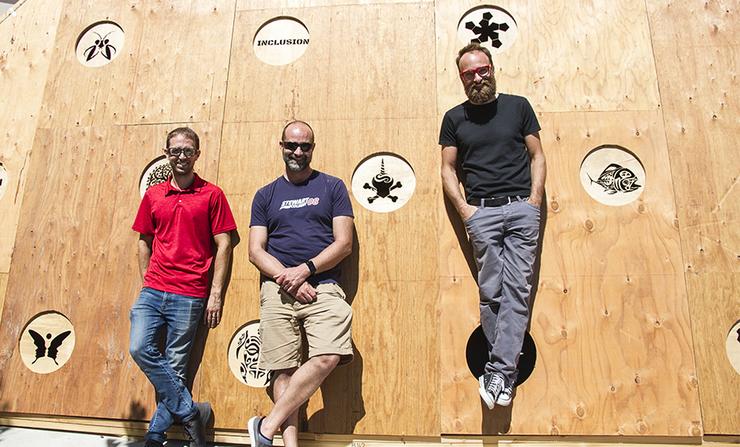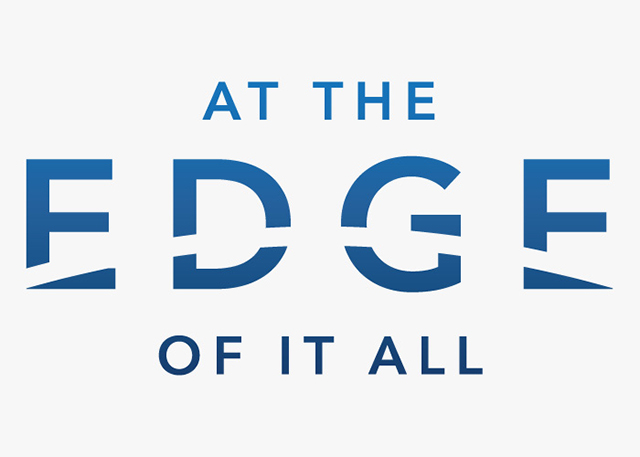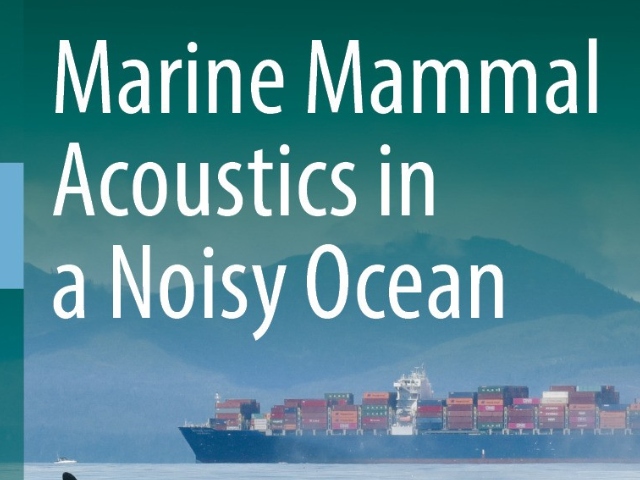Art Builds Seeks More Interdisciplinary Projects, Possibilities
 Three USD professors with Art Builds, from left, Gordon Hoople, Nate Parde and Austin Choi-Fitzpatrick, stand in front of About Time, an interactive sundial project they displayed at Burning Man.
Three USD professors with Art Builds, from left, Gordon Hoople, Nate Parde and Austin Choi-Fitzpatrick, stand in front of About Time, an interactive sundial project they displayed at Burning Man.If you ask the question, “What is art?” the answer might describe how a piece of art looks or a reflection upon how it has the power to move someone. Art can be visual or tactile, bold or muted, bright or dark, expressive or mysterious — even all of these at once. But always, art conveys a message or feeling expressed by the artist.
Ask this same question to a group of University of San Diego faculty members and the answers you'll get are again nearly limitless. Despite a providing satisfying answers, this group might mull it over for a bit and, ultimately, want to put the question into action. This group wants to take the meaning of art, mix it together with multiple academic disciplines and build something big, something with a purpose, as an applied creative project.
That’s undoubtedly the reason why a concept like Art Builds was created. Brought to fruition by USD professors Austin Choi-Fitzpatrick in the Kroc School of Peace Studies, Gordon Hoople from Integrated Engineering within the Shiley-Marcos School of Engineering, Diane Hoffoss in Mathematics, Nate Parde from Theatre Studies and several affiliated and supportive faculty who've made contributions, Art Builds is gaining momentum.
The last two summers the outside area adjacent to the machine shop at the Belanich Engineering Center has been where faculty, students, staff and community members, have taken an idea initially hatched on a piece of paper and have built an art sculpture that has been transported and displayed at the famed Burning Man event in the northern Nevada desert in late August.
“About Time came out of this idea that we're all slaves of time, that so much of our day is driven by our calendars. ‘I have to be at X place doing Y thing,’” says Hoople regarding the interactive sundial project built for Burning Man this past summer. “We realized we wanted to make an art piece that really forced people to think about this. We came up with this giant sundial that challenges people to really think, ‘Well, what is time?’”
Art Builds wants those that interact with the project to discover their own answers.
Choi-Fitzpatrick asks, “How do you translate these big ideas into something that's tangible, something that's physical, something people can interface with, engage with, know generally what it's about, but then generates their own meanings around it?”
While the questions are asked and the resulting answers might be lengthy, what’s certain is that something interesting will emerge from the conversation. Last fall, Choi-Fitzpatrick, who holds his office hours anywhere on campus, came up with the concept of a mobile desk project for transfer students. Called The Doctor is Out, this project had contributions from art, architecture, peace studies and engineering students. Many of the options they came up with were on display at the fall 2018 Transfer Learning Communities Integration Showcase.
One project that inspired Art Builds to get started was Unfolding Humanity. The effort, which was created by the San Diego Geometry Lab in 2018, was an interactive sculpture, a steel dodecahedron, covered in more than 17,000 LEDs which highlighted tension between technology and humanity. The project was built by more than 80 people, including Hoffoss, Hoople and Satyan Devadoss, the Fletcher Jones Chair of Applied Mathematics and Professor of Computer Science. The pentagonal walls of the sculpture unfold under human power and allude to Albrecht Durer's 500-year-old unsolved math problem on unfolding polyhedra.
“Art Builds came out of the interdisciplinary collaboration we had for Unfolding Humanity,” Hoople says. “It brought people from all over campus and it was clear there was interest and momentum for collaboration under the banner of art that had not been done before. It was exciting. Students were excited.”
“It was much more fulfilling than I expected,” says Hoffoss. “I was part of another project the year before Unfolding Humanity, which was cool, but it wasn't mine. Unfolding Humanity was one I felt I had ownership of, and it was the first project to involve students in a heavy way. There's a lot of enthusiasm and support. Now I’m sucked in. I was a part of four projects last summer and I've got to keep things at bay.”
So, maybe there is a limit? Not really. Hoffoss and her USD colleagues returned from Burning Man in September to their professorial roles and back into a routine. But she and her fellow peers know Art Builds is something great.
In recent semesters, Hoople and Choi-Fitzpatrick have co-taught a class involving using drones for good. The result is published research and a book about how having a peace studies professor and an engineering professor brings their respective perspectives and their students together to create innovative solutions. It was also a great example for Hoople, who in fall 2018 gave a talk at the Kroc School’s Peace Innovators event, about how bridging social and technical elements could connect to peace.
Art Builds is in its infancy. A website exists, so do email (artbuilds@sandiego.edu), Instagram and Facebook accounts. And Hoople, Hoffoss, Parde and Choi-Fitzpatrick are hosting an Art Builds event on April 27, 2020 at 4 p.m. in USD's Humanities Center.
“We're creating a space where people can come together, bring their ideas together and have resources to help them accomplish what they want to do. We’ve already had two students reach out to us with their ideas. When I got the email, I didn’t even know how to evaluate what it is, but it sounds amazing. Let us know what you need and how we can help.”
— Ryan T. Blystone
Contact:
USD News Center
news@sandiego.edu
(619) 260-4681



